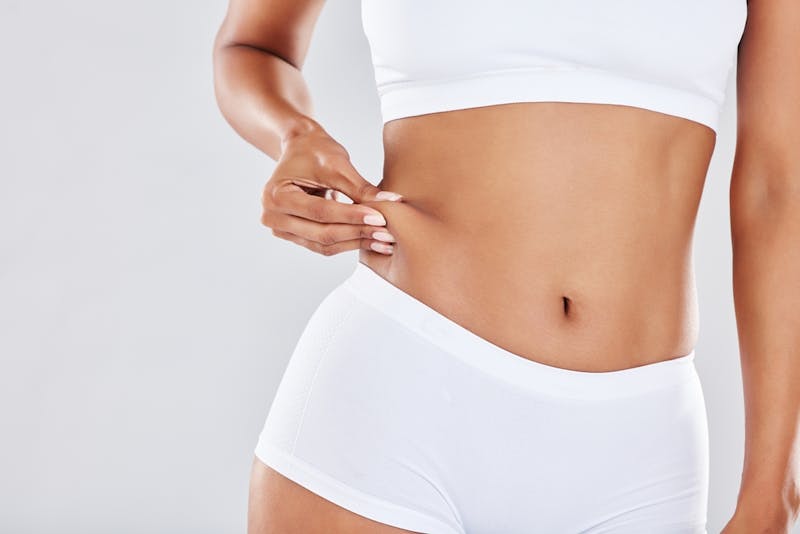
In the field of plastic surgery, liposuction is commonly associated with cosmetic procedures that seek to improve one’s physical appearance. However, it is important to acknowledge that liposuction serves a broader purpose beyond aesthetics. At Rios Center for Plastic Surgery in Edinburg, TX, we understand the significant role that liposuction plays in treating lipedema, a condition that not only impacts physical well-being but also has emotional repercussions.
What Is Lipedema?
Lipedema is a chronic and often misunderstood medical condition characterized by the abnormal and disproportionate accumulation of fatty tissue, usually in the lower half of the body, including the legs and sometimes the arms. Unlike typical fat distribution, lipedema fat is symmetrical and often painful, tender, or easily bruised; patients with lipedema tend to bruise easily in the affected areas. A distinctive sign of lipedema is the formation of “cuffs” or “bands” at the ankles or wrists, where the fat accumulation stops abruptly.
Lipedema is frequently misdiagnosed as simple obesity or lymphedema, leading to ineffective treatments. The lack of awareness and understanding of lipedema among medical professionals contributes to this misdiagnosis. Accurate diagnosis is crucial for effective treatment; however, it often comes late after patients have undergone numerous other unsuccessful therapies.
What Causes Lipedema?
The exact cause of lipedema is not entirely understood, but it is believed to be influenced by genetic and hormonal factors. Genetics plays a significant role in lipedema. Many individuals with this condition have family members who also have it, suggesting a hereditary component. This genetic predisposition means that lipedema can be passed down through generations. Hormonal factors are also crucial in the development of lipedema. The condition often becomes apparent or worsens during periods of significant hormonal change, such as puberty, pregnancy, and menopause.
How Can Lipedema Impact Someone’s Health?
The physical impact of lipedema on an individual’s quality of life can be profound and multifaceted. Those suffering from this condition often experience persistent pain and tenderness in the affected areas, ranging from a dull ache to severe discomfort, hindering daily activities and decreasing overall mobility. The disproportionate accumulation of fatty tissue, particularly in the lower extremities, can lead to joint pain, a heavy sensation in the limbs, and an increased risk of developing secondary conditions like varicose veins or lymphedema.
This excessive weight and volume in the legs or arms can make physical movements challenging, limiting the ability to engage in exercise, maintain physical fitness, or even perform basic tasks. Over time, the progressive nature of lipedema can lead to further joint deterioration and mobility issues, significantly reducing an individual’s ability to lead an active and independent life.
What Is Liposuction?
Liposuction is a surgical procedure that removes excess fat from specific body areas, providing patients with a more contoured silhouette. This popular cosmetic surgery can address areas of the body where diet and exercise have proven ineffective, such as the abdomen, thighs, and hips. During the procedure, a cannula is inserted through a small incision in the skin to suction out the fat cells.
How Can Liposuction Help With Lipedema?
Reduction of Pain and Discomfort
One of the primary benefits of liposuction for lipedema patients is the reduction of pain and tenderness in the affected areas. By removing the abnormal fat deposits, liposuction can alleviate the pressure on joints and surrounding tissues, decreasing pain and improving overall comfort.
Improved Mobility and Quality of Life
The excessive fat accumulation in lipedema can hinder movement and impact daily activities. Liposuction can significantly reduce the volume of the affected limbs, improving mobility and making it easier for patients to walk, exercise, and engage in daily tasks. This improvement in physical capabilities can significantly enhance the patient’s quality of life.
Better Response to Conservative Treatments
Following liposuction, patients often find that conservative treatments like compression therapy and manual lymphatic drainage become more effective. With the bulk of the lipedema fat removed, these therapies can more efficiently manage the remaining symptoms.
Long-Term Relief
Unlike other treatments that manage symptoms, liposuction offers a more long-term solution by physically removing the lipedema fat. While it’s not a cure, as lipedema can progress or recur, liposuction can provide substantial and lasting relief from the most debilitating aspects of the condition.
How Can You Get Started With Liposuction for Lipedema?
Getting started with liposuction for lipedema treatment begins with a comprehensive consultation with us. During this initial meeting, we assess your medical history, conduct a physical examination, and discuss your symptoms and concerns to determine if you are a suitable candidate for the procedure.
This consultation allows you to understand the specifics of liposuction as it applies to lipedema, including the expected outcomes, the procedure process, recovery time, and any potential risks. It’s also a time to ask questions and express concerns. We develop a personalized treatment plan tailored to your needs based on this evaluation. We aim to ensure you are fully informed and comfortable with the proposed treatment plan before moving forward with liposuction for lipedema.
Restore Your Mobility and Reduce Pain With Liposuction for Lipedema in Edinburg, TX
At Rios Center for Plastic Surgery in Edinburg, TX, we offer liposuction surgery as an effective treatment option for lipedema patients. We have extensive experience in performing liposuction procedures with precision and care. Lipedema is a condition that causes an abnormal accumulation of fat in the legs, arms, and buttocks. If left untreated, it can lead to health problems such as chronic pain, mobility issues, and lymphedema. Contact us online or call (956) 682-3147 to schedule a consultation with us and learn how we can help you achieve relief from lipedema.
Back to Blog

